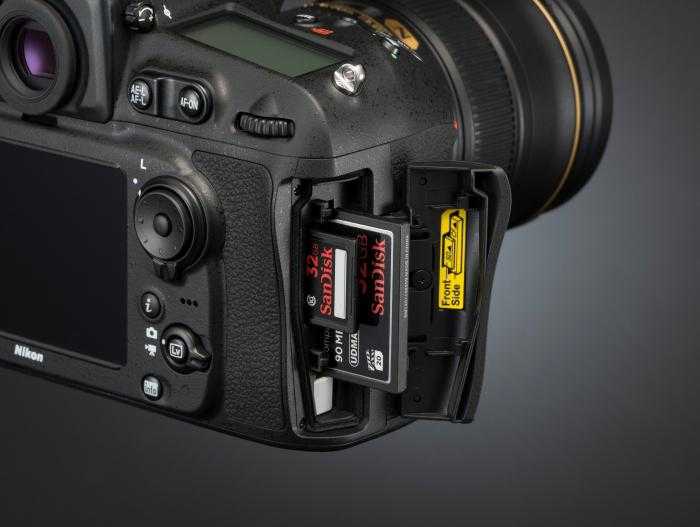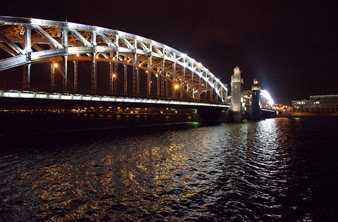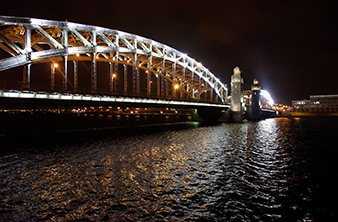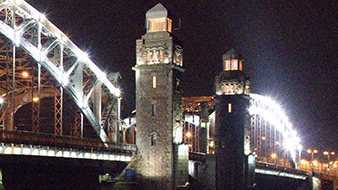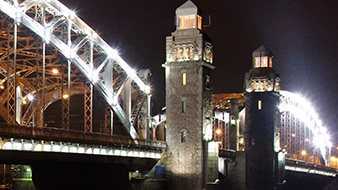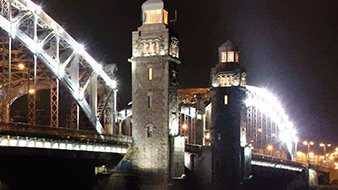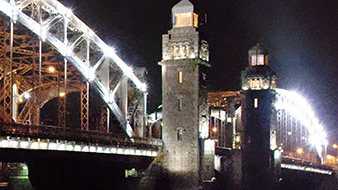Connectivity comparison
For some imaging applications, the extent to which a camera can communicate with its environment can be an important aspect in the camera decision process. The table below provides an overview of the connectivity of the Nikon D3 and Nikon D810 and, in particular, the interfaces the cameras (and selected comparators) provide for accessory control and data transfer.
| Camera Model | Hotshoe Port | Internal Mic / Speaker | Microphone Port | Headphone Port | HDMI Port | USB Port | WiFi Support | NFC Support | Bluetooth Support | ||
|---|---|---|---|---|---|---|---|---|---|---|---|
| 1. | Nikon D3 | Y | — / — | — | — | mini | 2.0 | — | — | — | |
| 2. | Nikon D810 | Y | stereo / mono | Y | Y | mini | 3.0 | Y | — | — | |
| 3. | Canon 5DS | Y | mono / mono | Y | — | mini | 3.0 | — | — | — | |
| 4. | Canon 1D Mark III | Y | — / — | — | — | — | 2.0 | — | — | — | |
| 5. | Nikon D850 | Y | stereo / mono | Y | Y | mini | 3.0 | Y | Y | Y | |
| 6. | Nikon D5 | Y | stereo / mono | Y | Y | mini | 3.0 | — | — | — | |
| 7. | Nikon D4S | Y | mono / mono | Y | Y | mini | 2.0 | — | — | — | |
| 8. | Nikon D610 | Y | mono / mono | Y | Y | mini | 2.0 | — | — | — | |
| 9. | Nikon D4 | Y | mono / mono | Y | Y | micro | 2.0 | — | — | — | |
| 10. | Nikon D800 | Y | mono / mono | Y | Y | mini | 3.0 | — | — | — | |
| 11. | Nikon D800E | Y | mono / mono | Y | Y | mini | 3.0 | — | — | — | |
| 12. | Nikon D3S | Y | stereo / — | — | — | mini | 2.0 | — | — | — | |
| 13. | Nikon D3X | Y | — / — | — | — | mini | 2.0 | — | — | — | |
| 14. | Nikon D700 | Y | — / — | — | — | mini | 2.0 | — | — | — | |
| 15. | Nikon D300 | Y | — / — | — | — | mini | 2.0 | — | — | — | |
| 16. | Nikon D2Xs | Y | — / — | — | — | — | 2.0 | — | — | — | |
| 17. | Nikon D2X | Y | — / — | — | — | — | 2.0 | — | — | — |
It is notable that the D810 offers wifi support, which can be a very convenient means to transfer image data
to an off-camera location. In contrast, the D3 does not provide wifi capability.
Both cameras feature a PC Sync terminal to control professional strobe lights, which will be appreciated by studio photographers.
Both the D3 and the D810 have been discontinued, but can regularly be found used
on ebay. The D3 was replaced by the Nikon D4, while the D810 was followed by the Nikon D850. Further information on the features and operation of the D3 and D810 can be found, respectively, in the
Nikon D3 Manual (free pdf) or the
online Nikon D810 Manual.
Сравнение матриц трёх полнокадровых камер
Компания DxO Labs провела научное исследование – сравнение матриц трёх полнокадровых фотокамер – Nikon D810, Sony A7R и Canon EOS 5D Mark III:
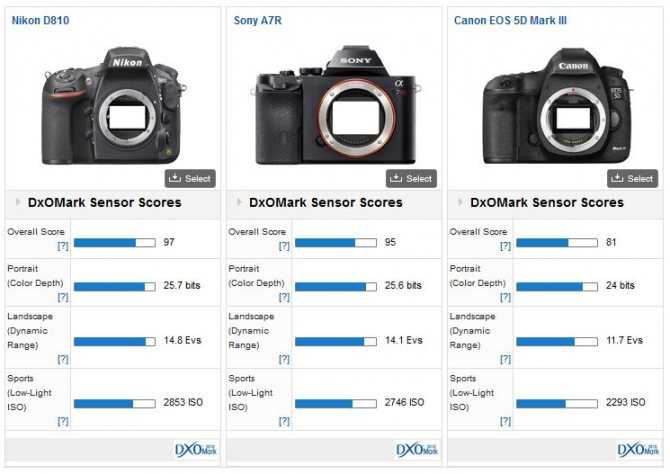
Процитируем вывод, который сделали инженеры DxO Labs:
«Анонсировав в 2012 году на выставке Photokina модель D800, компания Nikon почувствовала сильную конкуренцию со стороны 22-мегапиксельной камеры Canon EOS 5D Mark III, модели с меньшим количеством пикселей матрицы, которая, однако, обеспечивает огромную эффективность и разрешающую способность. Позже компания Sony анонсировала A7R, беззеркальную камеру в более компактном и лёгком корпусе, в которой установлен подобный D810 36-мегапиксельный датчик Sony без низкочастотного сглаживающего фильтра. И не удивительно, что результаты Sony A7R являются самыми близкими к D810 в наших тестах. Наблюдается улучшение в глубине цвета +1 стоп по отношению к Canon на базовых значениях ISO, но это преимущество исчезает при более высоких ISO. К тому же, примечательно, что D810, имеет +0.7 стопа в динамическом диапазоне, чем Sony на базовых значениях ISO. Canon неплохо снимает при слабом освещении, в остальном все три модели более или менее равны.»
Картинка у компании DxO вышла не очень достоверная – глядя на неё создается ощущение, что матрица у Sony больше по размерам. На самом деле здесь просто не учтён масштаб – у Sony более компактный корпус, нежели у двух других камер, на картинке её нужно было просто уменьшить. Последняя фраза про Canon в оригинале звучит как «The Canon shows it’s a capable performer in low light», в то время как на диаграмме очевиден провал показателей; вероятно, автор имел в виду, что несмотря на более низкие значения, Canon по факту снимает круто.
Body comparison
An illustration of the physical size and weight of the Nikon D3 and the Nikon D810 is provided in the side-by-side display below. The two cameras are presented according to their relative size. Three successive views from the front, the top, and the rear are shown. All size dimensions are rounded to the nearest millimeter.
If the front view area (width x height) of the cameras is taken as an aggregate measure of their size,
the Nikon D810 is notably smaller (29 percent) than the Nikon D3. Moreover, the D810 is markedly lighter (25 percent) than the D3. In this context, it is worth noting that both cameras are splash and dust-proof and can, hence, be used in inclement weather conditions or harsh environments.
The above size and weight comparisons are to some extent incomplete since they do not consider the interchangeable lenses
that both of these cameras require. In this particular case, both cameras feature the same lens mount, so that they can use the same lenses.
You can compare the optics available in the Nikon Lens Catalog.
Concerning battery life, the D3 gets 4300 shots out of its EN-EL4a battery,
while the D810 can take 1200 images on a single charge of its EN-EL15 power pack. As can be seen in the images above, the D3 has a battery grip built in. This facilitates image-taking in portrait orientation
and gives it additional battery power. In order to provide similar functionality for the D810, Nikon provides the MB-D12 vertical grip as an optional accessory
(see here on ebay).
The adjacent table lists the principal physical characteristics of the two cameras alongside a wider set of alternatives. In case you want to display and compare another camera duo, you can use the CAM-parator app to
select your camera combination among a large number of options.
| Camera Model | Camera Width | Camera Height | Camera Depth | Camera Weight | Battery Life | Weather Sealing | Camera Launch | Launch Price (USD) | Street Price | ||
|---|---|---|---|---|---|---|---|---|---|---|---|
| Note: Measurements and pricing do not include easily detachable parts, such as add-on or interchangeable lenses or optional viewfinders. | |||||||||||
| Convert to Imperial | |||||||||||
| 1. | Nikon D3 | 160 mm | 157 mm | 88 mm | 1300 g | 4300 | Y | Aug 2007 | 4,999 | ebay.com | |
| 2. | Nikon D810 | 146 mm | 123 mm | 82 mm | 980 g | 1200 | Y | Jun 2014 | 3,299 | ebay.com | |
| 3. | Canon 5DS | 152 mm | 116 mm | 76 mm | 930 g | 700 | Y | Feb 2015 | 3,699 | ebay.com | |
| 4. | Canon 1D Mark III | 156 mm | 157 mm | 80 mm | 1155 g | 2200 | Y | Feb 2007 | 4,499 | ebay.com | |
| 5. | Nikon D850 | 146 mm | 124 mm | 79 mm | 1005 g | 1840 | Y | Jul 2017 | 3,299 | amazon.com | |
| 6. | Nikon D5 | 160 mm | 159 mm | 92 mm | 1415 g | 3780 | Y | Jan 2016 | 6,499 | ebay.com | |
| 7. | Nikon D4S | 160 mm | 157 mm | 91 mm | 1350 g | 3020 | Y | Feb 2014 | 6,499 | ebay.com | |
| 8. | Nikon D610 | 141 mm | 113 mm | 82 mm | 850 g | 900 | Y | Oct 2013 | 1,999 | ebay.com | |
| 9. | Nikon D4 | 160 mm | 157 mm | 91 mm | 1340 g | 2600 | Y | Jan 2012 | 5,999 | ebay.com | |
| 10. | Nikon D800 | 146 mm | 123 mm | 82 mm | 1000 g | 900 | Y | Feb 2012 | 2,999 | ebay.com | |
| 11. | Nikon D800E | 146 mm | 123 mm | 82 mm | 1000 g | 900 | Y | Feb 2012 | 3,299 | ebay.com | |
| 12. | Nikon D3S | 160 mm | 157 mm | 88 mm | 1240 g | 4200 | Y | Oct 2009 | 5,199 | ebay.com | |
| 13. | Nikon D3X | 160 mm | 157 mm | 88 mm | 1260 g | 4400 | Y | Dec 2008 | 7,999 | ebay.com | |
| 14. | Nikon D700 | 147 mm | 123 mm | 77 mm | 1074 g | 1000 | Y | Jul 2008 | 2,999 | ebay.com | |
| 15. | Nikon D300 | 147 mm | 114 mm | 74 mm | 925 g | 1000 | Y | Aug 2007 | 1,799 | ebay.com | |
| 16. | Nikon D2Xs | 158 mm | 150 mm | 86 mm | 1252 g | 3800 | Y | Jun 2006 | 4,699 | ebay.com | |
| 17. | Nikon D2X | 158 mm | 150 mm | 86 mm | 1252 g | 3800 | Y | Sep 2004 | 4,999 | ebay.com |
The price is, of course, an important factor in any camera decision. The listed launch prices provide an indication of the market segment that the manufacturer of the cameras have been targeting. The D810 was launched at a markedly lower price (by 34 percent) than the D3, which puts it into a different market segment. Normally, street prices remain initially close to the MSRP, but after a couple of months, the first discounts appear. Later in the product cycle and, in particular, when the replacement model is about to appear, further discounting and stock clearance sales often push the camera price considerably down.
Основные отличия Nikon D810 от Nikon D750 и D610
| Nikon D610 | Nikon D750 | Nikon D810 | |
| Матрица | 24,3 Мп типа КМОП | 24,3 Мп типа КМОП | 36,3 Мп типа КМОП |
| Процессор | EXPEED 3 | EXPEED 4 | EXPEED 4 |
| Автофокус | 39-точечная система АФ Nikon Multi-CAM 4800 | 51-точечная система АФ Multi-CAM 3500FX II | 51-точечная система АФ Multi-CAM 3500FX |
| Скорость съёмки | 6 к/с | 6,5 к/с | 5 к/с |
| ISO | 50 – 25600 | 50 – 51200 | 32 – 51200 |
| Видео | 1920 x 1080; 30p, 25p, 24p. 1280 x 720; 60p, 50p, 30p, 25p | 1920 x 1080; 60p, 50p, 30p, 25p, 24p; 1280 x 720; 60p, 50p | 1920 x 1080; 60p, 50p, 30p, 25p, 24p, 1280 x 720p; 60p, 50p |
| Вспышка | ДА | ДА | ДА |
| Экран | Диагональ 8 см; TFT с углом обзора 170°, покрытием кадра прибл. 100% и автоматической регулировкой яркости. Разрешение: 921000 точек (VGA) | Наклонный, диагональ 8 см; TFT с углом обзора 170°, покрытием кадра прибл. 100% и регулировкой яркости. Разрешение: прибл. 1229000 точек | Диагональ 8 см; TFT с углом обзора 170°, покрытием кадра прибл. 100% и регулировкой яркости. Разрешение: прибл. 1229000 точек |
| Wi-Fi | — | ДА | — |
| Размеры / вес | 141 x 113 x 82 мм / 850 г | 140,5 x 113 x 78 мм / 840 г | 146 x 123 x 81,5 мм / 980 г |
| Цена body по данным ЯМ (декабрь 2015 г.)* | 82 990 руб. | 109 750 руб. | 179 890 руб. |
Тест чувствительности ISO
Стандартными значениями являются ISO 64 – 12800 с шагом в 1/3 EV. Настройки от Hi-0,3 до Hi-2 соответствуют значениям выше ISO 12800 – эквивалент ISO 16000–51200.
Настройки от Lo-0,3 до Lo-1 соответствуют значениям ниже ISO 64, другими словами, это значения ISO 50, 40 и 31. Такие низкие значения могу быть полезными пейзажным фотографам для заморозки движения или для съёмки на открытых диафрагмах в яркий день, в том числе со вспышкой. При этом контраст снимков получится немного выше обычного, но для большинства ситуаций съёмки следует использовать чувствительность ISO 64 или выше.
Параметры съёмки: со штатива, приоритет диафрагмы f/8, фокусное расстояние 24 мм.
| 31 | 40 | 50 |
| 64 | 80 | 100 |
| 125 | 160 | 200 |
| 250 | 320 | 400 |
| 500 | 640 | 800 |
| 1000 | 1250 | 1600 |
| 2000 | 2500 | 3200 |
| 4000 | 5000 | 6400 |
| 8000 | 10000 | 12800 |
| 16000 | 20000 | 25600 |
| 51200 |
Auto ISO
Говоря про управлением чувствительностью ISO, нужно упомянуть про такую немаловажную функцию, как Auto ISO. Очень часто при съёмке репортажа освещённость меняется, и чтобы постоянно не менять ISO вручную, удобно включить автоматический режим. Можно это выбрать в меню: Меню режима съёмки – Настройки чувствит. ISO – Авт. управл. чувствит. ISO, но гораздо удобнее менять эту настройку так – если нажать управляющую кнопку ISO сверху слева на корпусе камеры, то переднее колесико (которое под указательным пальцем) будет включать и отключать Auto ISO, а заднее – изменять само значение ISO. Это очень удобно!
Экстремальные значения ISO
Кадры с экстремальными ISO можно попробовать обрабатывать в новой версии программы DXO Optics Pro 10, а которой есть уникальная технология борьбы с шумом PRIME. Посмотрите результат её работы на примере с кадром, снятым на D810 с чувствительностью ISO 12800. На экраннике ниже показан процесс обработки. Особенность обработки с помощью технологии PRIME в том, что на экране не отображается результат, только в маленьком окошке, которое показано справа в палитре инструментов, рамкой на изображении показана данная область. Результат можно посмотреть только при экспорте. Как видно на экраннике, никакая другая обработка не применялась. Ниже показаны результаты экспорта – слева оригинал, а справа обработка.
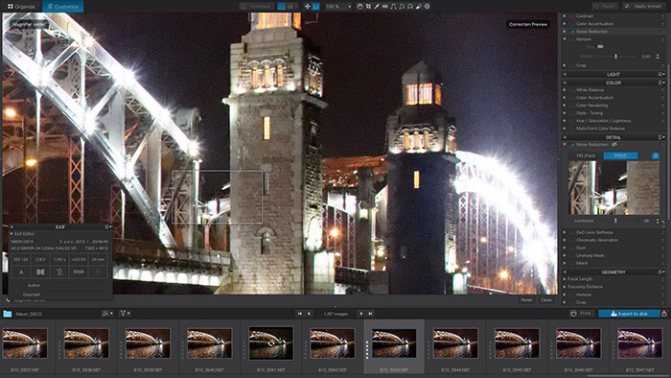
|
|
|
| без обработки, весь кадр (по щелчку – 1920 px по ширине) | обработка PRIME, весь кадр (по щелчку – 1920 px по ширине) |
|
|
|
| без обработки, по щелчку – кроп 100% | обработка PRIME, по щелчку – кроп 100% |
Как DxO PRIME справится с ещё большими значениями ISO? Смотрим:
|
|
|
| ISO 25600, обработка PRIME, по щелчку – кроп 100% | ISO 51200, обработка PRIME, по щелчку – кроп 100% |
Работа инструмента впечатляет, возьмите на заметку эту технологию. Также впечатлает детализация камеры Nikon D810 на ISO 12800 – на пролётах моста можно рассматривать заклёпки, это невероятно.

Expert reviews
This is where reviews by experts come in. The table below provides a synthesis of the camera assessments of some of the best known photo-gear review sites (amateurphotographer , cameralabs , digitalcameraworld , dpreview , ephotozine , photographyblog ). As can be seen, the professional reviewers agree in many cases on the quality of different cameras, but sometimes their assessments diverge,
reinforcing the earlier point that a camera decision is often a very personal choice.
| Camera Model | AP score | CL score | DCW score | DPR score | EPZ score | PB score | Camera Launch | Launch Price (USD) | Street Price | ||
|---|---|---|---|---|---|---|---|---|---|---|---|
| Notes: (+ +) highly recommended; (+) recommended; (o) reviewed; (..) not available. | |||||||||||
| 1. | Nikon D3 | .. | .. | .. | + + | 5/5 | 4.5/5 | Aug 2007 | 4,999 | ebay.com | |
| 2. | Nikon D810 | 5/5 | .. | 5/5 | 86/100 | 5/5 | 4.5/5 | Jun 2014 | 3,299 | ebay.com | |
| 3. | Canon 5DS | .. | + | .. | 83/100 | 4.5/5 | 4.5/5 | Feb 2015 | 3,699 | ebay.com | |
| 4. | Canon 1D Mark III | .. | .. | .. | .. | .. | .. | Feb 2007 | 4,499 | ebay.com | |
| 5. | Nikon D850 | 4.5/5 | + + | 5/5 | 89/100 | 4.5/5 | 5/5 | Jul 2017 | 3,299 | amazon.com | |
| 6. | Nikon D5 | .. | .. | 4/5 | 89/100 | 4.5/5 | 5/5 | Jan 2016 | 6,499 | ebay.com | |
| 7. | Nikon D4S | 5/5 | .. | .. | .. | 4.5/5 | 4.5/5 | Feb 2014 | 6,499 | ebay.com | |
| 8. | Nikon D610 | 4/5 | + + | .. | 87/100 | 4.5/5 | 4.5/5 | Oct 2013 | 1,999 | ebay.com | |
| 9. | Nikon D4 | .. | .. | .. | .. | 4.5/5 | 4.5/5 | Jan 2012 | 5,999 | ebay.com | |
| 10. | Nikon D800 | 5/5 | + + | .. | 82/100 | 5/5 | 5/5 | Feb 2012 | 2,999 | ebay.com | |
| 11. | Nikon D800E | .. | .. | .. | 84/100 | 5/5 | 5/5 | Feb 2012 | 3,299 | ebay.com | |
| 12. | Nikon D3S | 5/5 | .. | .. | 89/100 | 4.5/5 | 5/5 | Oct 2009 | 5,199 | ebay.com | |
| 13. | Nikon D3X | .. | .. | .. | 86/100 | 4/5 | 5/5 | Dec 2008 | 7,999 | ebay.com | |
| 14. | Nikon D700 | .. | 89/100 | .. | + + | 4.5/5 | 4.5/5 | Jul 2008 | 2,999 | ebay.com | |
| 15. | Nikon D300 | .. | + + | .. | + + | 5/5 | 4.5/5 | Aug 2007 | 1,799 | ebay.com | |
| 16. | Nikon D2Xs | .. | .. | .. | .. | .. | .. | Jun 2006 | 4,699 | ebay.com | |
| 17. | Nikon D2X | .. | .. | .. | + + | .. | .. | Sep 2004 | 4,999 | ebay.com |
The above review scores should be interpreted with care, though. The ratings were established in reference to similarly priced cameras that were available in the market at the time of the review. Thus, a score needs to be put into the context of the launch date and the launch price of the camera, and comparing ratings of very distinct cameras or ones that are far apart in terms of their release date have little meaning. Also, kindly note that some of the listed sites have over time developped their review approaches and their reporting style.
Check D3 offers atebay.com
Check D810 offers atebay.com
Review summary
So what conclusions can be drawn? Which of the two cameras – the Nikon D3 or the Nikon D810 – has the upper hand? Is one clearly better than the other? A synthesis of the relative strong points of each of the models is listed below.
Reasons to prefer the Nikon D3:
- Better moiré control: Has an anti-alias filter to avoid artificial patterns to appear in images.
- Faster burst: Shoots at higher frequency (11 vs 5 flaps/sec) to capture the decisive moment.
- More portrait friendly: Features an integrated vertical grip for easier portrait shooting.
- Longer lasting: Can take more shots (4300 versus 1200) on a single battery charge.
- More heavily discounted: Has been available for much longer (launched in August 2007).
Advantages of the Nikon D810:
- More detail: Has more megapixels (36.2 vs 12.1MP), which boosts linear resolution by 73%.
- Maximized detail: Lacks an anti-alias filter to exploit the sensor’s full resolution potential.
- Better image quality: Scores substantially higher (16 points) in the DXO overall evaluation.
- Richer colors: Generates noticeably more natural colors (2.2 bits more color depth).
- More dynamic range: Captures a broader range of light and dark details (2.6 EV of extra DR).
- Better jpgs: Has a more modern image processing engine (EXPEED 4 vs EXPEED).
- Broader imaging potential: Can capture not only stills but also 1080/60p video.
- Larger screen: Has a bigger rear LCD (3.2″ vs 3.0″) for image review and settings control.
- More detailed LCD: Has a higher resolution rear screen (1229k vs 922k dots).
- More compact: Is smaller (146x123mm vs 160x157mm) and will fit more readily into a bag.
- Less heavy: Has a lower weight (by 320g or 25 percent) and is thus easier to take along.
- Easier fill-in: Has a small integrated flash to brighten shadows of backlit subjects.
- Faster data transfer: Supports a more advanced USB protocol (3.0 vs 2.0).
- Easier file upload: Has wifi built in for automatic backup or image transfer to the web.
- More affordable: Was introduced into a lower priced category (34 percent cheaper at launch).
- More modern: Reflects 6 years and 10 months of technical progress since the D3 launch.
If the count of relative strengths (bullet points above) is taken as a measure, the D810 is the clear winner of the contest (16 : 5 points). However, the relevance of individual strengths will vary across photographers, so that you might want to apply your own weighing scheme to the summary points when reflecting and deciding on a new camera. A professional wildlife photographer will view the differences between cameras in a way that diverges
from the perspective of a family photog, and a person interested in architecture has distinct needs from a sports shooter. Hence, the decision which camera
is best and worth buying is often a very personal one.
D3 0516 D810
How about other alternatives? Do the specifications of the Nikon D3 and the Nikon D810 place the cameras among the top in their class? Find out in the latest
Best DSLR Camera listing whether the two cameras rank among the cream of the crop.
In any case, while the comparison of technical specifications can provide a useful overview of the capabilities of different cameras, it remains partial and cannot reveal, for example, the shooting experience and imaging performance when actually working with the D3 or the D810. User reviews, such as those found at amazon, can sometimes inform about these issues, but such feedback is often incomplete, inconsistent, and biased.
Other camera comparisons
Did this review help to inform your camera decision process? In case you are interested in seeing how other cameras pair up, just make your choice using the following search menu. Alternatively, you can follow any of the listed hyperlinks for comparisons that others found interesting.
- Canon 1D Mark IV vs Nikon D3
- Canon 5D Mark III vs Nikon D3
- Canon R5 vs Nikon D3
- Kodak S-1 vs Nikon D810
- Nikon D3 vs Nikon D40
- Nikon D3 vs Nikon P950
- Nikon D3 vs Panasonic GH2
- Nikon D810 vs Olympus E-400
- Nikon D810 vs Olympus E-500
- Nikon D810 vs Panasonic LX10
- Nikon D810 vs Sony RX100 III
- Nikon D810 vs YI M1
Specifications: Nikon D3 vs Nikon D810
Below is a side-by-side comparison of the specs of the two cameras to facilitate a quick review of their differences and common features.
| Camera Model | Nikon D3 | Nikon D810 |
| Camera Type | Digital single lens reflex | Digital single lens reflex |
| Camera Lens | Nikon F mount lenses | Nikon F mount lenses |
| Launch Date | August 2007 | June 2014 |
| Launch Price | USD 4,999 | USD 3,299 |
| Sensor Specs | Nikon D3 | Nikon D810 |
|---|---|---|
| Sensor Technology | CMOS | CMOS |
| Sensor Format | Full Frame Sensor | Full Frame Sensor |
| Sensor Size | 36.0 x 23.9 mm | 35.9 x 24.0 mm |
| Sensor Area | 860.4 mm2 | 861.6 mm2 |
| Sensor Diagonal | 43.2 mm | 43.2 mm |
| Crop Factor | 1.0x | 1.0x |
| Sensor Resolution | 12.1 Megapixels | 36.2 Megapixels |
| Image Resolution | 4256 x 2832 pixels | 7360 x 4912 pixels |
| Pixel Pitch | 8.43 μm | 4.88 μm |
| Pixel Density | 1.40 MP/cm2 | 4.20 MP/cm2 |
| Moiré control | Anti-Alias filter | no AA filter |
| Movie Capability | no Video | 1080/60p Video |
| ISO Setting | 200 — 6,400 ISO | 64 — 12,800 ISO |
| ISO Boost | 100 — 25,600 ISO | 32 — 51,200 ISO |
| Image Processor | EXPEED | EXPEED 4 |
| DXO Sensor Quality (score) | 81 | 97 |
| DXO Color Depth (bits) | 23.5 | 25.7 |
| DXO Dynamic Range (EV) | 12.2 | 14.8 |
| DXO Low Light (ISO) | 2290 | 2853 |
| Screen Specs | Nikon D3 | Nikon D810 |
| Viewfinder Type | Optical viewfinder | Optical viewfinder |
| Viewfinder Field of View | 100% | 100% |
| Viewfinder Magnification | 0.70x | 0.70x |
| Top-Level Screen | Control Panel | Control Panel |
| LCD Framing | Live View | Live View |
| Rear LCD Size | 3.0inch | 3.2inch |
| LCD Resolution | 922k dots | 1229k dots |
| LCD Attachment | Fixed screen | Fixed screen |
| Shooting Specs | Nikon D3 | Nikon D810 |
| Focus System | Phase-detect AF | Phase-detect AF |
| Continuous Shooting | 11 shutter flaps/s | 5 shutter flaps/s |
| Shutter Life Expectancy | 300 000 actuations | 200 000 actuations |
| Time-Lapse Photography | Intervalometer built-in | Intervalometer built-in |
| Fill Flash | no On-Board Flash | Built-in Flash |
| Storage Medium | CF cards | CF or SDXC cards |
| Single or Dual Card Slots | Dual card slots | Dual card slots |
| Connectivity Specs | Nikon D3 | Nikon D810 |
| External Flash | Hotshoe | Hotshoe |
| Studio Flash | PC Sync socket | PC Sync socket |
| USB Connector | USB 2.0 | USB 3.0 |
| HDMI Port | mini HDMI | mini HDMI |
| Microphone Port | no MIC socket | External MIC port |
| Headphone Socket | no Headphone port | Headphone port |
| Wifi Support | no Wifi | Wifi built-in |
| Body Specs | Nikon D3 | Nikon D810 |
| Environmental Sealing | Weathersealed body | Weathersealed body |
| Battery Type | EN-EL4a | EN-EL15 |
| Battery Life (CIPA) | 4300 shots per charge | 1200 shots per charge |
| Body Dimensions |
160 x 157 x 88 mm (6.3 x 6.2 x 3.5 in) |
146 x 123 x 82 mm (5.7 x 4.8 x 3.2 in) |
| Camera Weight | 1300 g (45.9 oz) | 980 g (34.6 oz) |
Check D3 offers atebay.com
Check D810 offers atebay.com
Первое впечатление о макрокомплекте Nikon R1C1
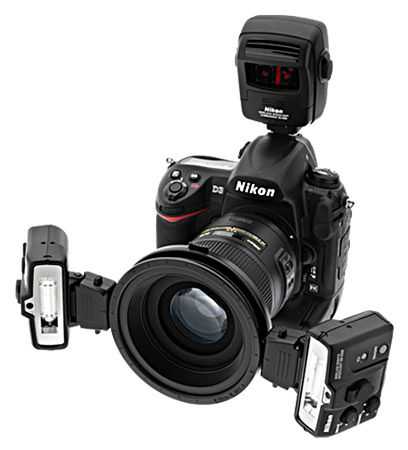
Через 2 года я все же решил вернуться к тому, к чему лежала душа изначально. Правда помог случай — нашел комплект R1C1 новье за хорошую цену, не смог устоять. Тем более, что за два года и проблемы с батарейками и аккумуляторами решились — все можно спокойно купить и в Москве, и макрик 105/2.8 VR прикупил.
Меня бы устроил и комплект R1, но случай подвернулся, грех было отказываться .

В комплект R1C1 входят:
1) ИК-контроллер вспышек SU-800 с чехлом 2) Две макровспышки SB-R200 с гелевыми светофильтрами, их держателем, макрорассеивателями, подставками, чехлами 3) Установочное кольцо с комплектом переходных адаптеров на объективы разных диаметров от 52 до 77, чехол для кольца 4) Белый пластиковый рассеиватель с гибким держателем 5) Специальный отражатель для встроенной вспышки, уменьшает блик в режиме коммандера
6) Черный кофр, куда все это добро упаковывается
В общем, комплект — мечта макрушника, особенно меня порадовал гибкий держатель — очень удобная штука, помогает закрепить объект неподвижно перед макрообъективом.
Сначала купил батарейки (тип CR-123A), но они довольно дороги, так что озаботился поиском аккумуляторов. Больше всего смущало ограничение 3 В, тогда как большинство LiIon аккумуляторов 3.7 В. Ответ нашелся на хорошем форуме по выбору фонариков — аккумуляторы, сделанные по технологии LiFePO4. Они обладают всеми плюсами батареек, безопасны, имеют низкое максимальное напряжение 3.2 В. Итого купил несколько аккумуляторов AW LiFePO4 500 мАч 3.2 В. Качественный китайский бренд. Минусы этих аккумуляторов — все же емкость ниже, чем у батареек (в три раза, у батареек 1400-1500 мАч), и они довольно дороги. В принципе, некоторые коллеги используют незащищенные китайские LiIon аккумуляторы с искусственно пониженным напряжением, но лично мне рисковать не хочется.
SU-800 оказался на редкость полезной штукой, хотя я изначально на счет него был настроен скептически — вроде есть коммандер в камере. На деле — куча плюсов:
1) Появилась возможность управлять 3-мя группами, где в качестве третьей может выступать внешняя вспышка, которых у меня еще две штуки. Можно очень интересно свет ставить в макро. 2) Дальность работы SU-800 на несколько метров дальше, чем коммандер встроенной. 3) SU-800 не дает блик от управляющей вспышки, а он есть, даже когда используется специальный рассеиватель. 4) На SU-800 есть переключатель пилотного света макровспышек. Это был для меня самый большой сюрприз, на SB-R200 есть пилотная подсветка. Правда, она отключается после вспыха, но применений можно найти много. 5) У SU-800 есть лампа подсветки фокуса, как на вспышке. То есть можно снимать что-то в полной темноте. 6) SU-800 поддерживает FP (высокоскоростную синхронизацию)
7) SU-800 поддерживает режим RPT на внешних вспышках, вроде SB-900. Я пока не пользуюсь, но знать полезно.
Теперь немного о сравнении R1C1 с моим «большим» двухвспышечным макрокомплектом.
Плюсы: 1) Комплект стал заметно меньше весить 2) Комплект проще и быстрее собирать 3) Комплект компактнее, можно залезть туда, куда с «большим» не залезешь
4) Вспышки на кольце можно поворачивать и размещат ьпод разными углами, что позволяет менять ориентацию камеры и вспышек независимо, это очень полезно
Минусы: 1) Скорость перезарядки вспышек ниже. SB-900 перезаряжались за 2.5-3 секунды, SR-R200 в лучшем случае за 5-6 секунд.
2) На объектив не могу надеть макроконверторы RAYNOX, большее увеличение можно теперь получить только с помощью телеконвертора. Или купить макрокольца.
Для информации о возможностях рассеивания света от моих комплектов пока недостаточно материала обработал. И тот, и другой будут у меня использоваться для разных задач, так что вывод о однозначном лидере я опускаю .
Вот фотография моего макрокомлекта с R1C1: nikon D7000, MB-D11, nikkor 105/2.8 VR, SU-800, 2 x SB-R200:
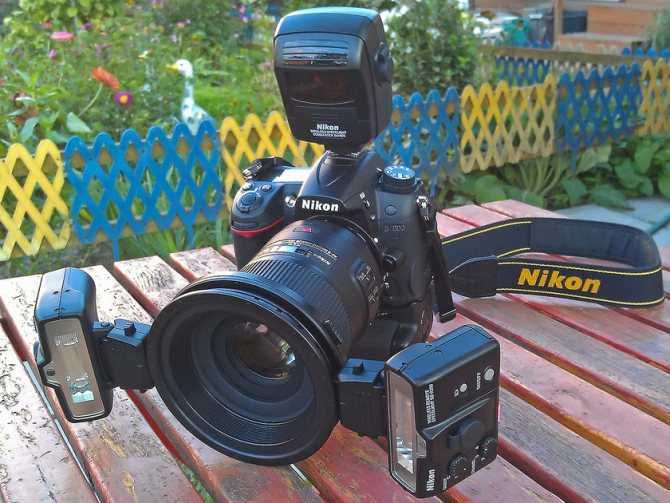
А теперь несколько фотографий с первой фотосессии:
В этом фото использовал комплектные рассеиватели, установленные на вспышки. Они предназначены для съемки на самое близкое расстояние — 15 см, что совпадает с рабочим расстоянием AF-S 105/2.8 VR. Это еще раз подтверждает, что комплект R1C1 по большей части разрабатывался, чтобы служить с этим макрообъективом.
Здесь вспышки без комплектных рассеивателей, конфигурация как на фото макрокомплекта выше.
Общие сведения
Полупрофессиональный цифровой однообъективный зеркальный фотоаппарат с полнокадровой матрицей (FX) и разрешением 36 мегапикселей. Два разъёма для карт памяти (CF и SD).
Год начала выпуска: 2014 (D810), 2015 (D810A).
Цена (март, 2018): 2200 $ (без объектива), 3000 $ (D810A без объектива).
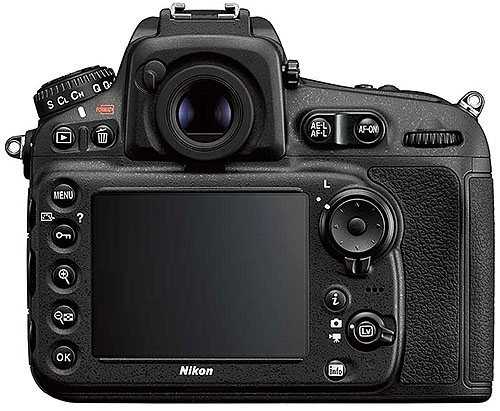
Nikon D810, строго говоря, не является полностью новой моделью, а представляет собой скорее D800E с некоторыми незначительными изменениями и усовершенствованиями. Заслуживающие внимания отличия следующие:
- «Обновлённая» 36-мегапиксельная матрица без оптического фильтра нижних частот. Диапазон ISO расширен до 32-51200.
- Процессор EXPEED4 с улучшенным подавлением муара и возможностью записи файлов в формате sNEF (NEF с разрешением 9 Мп).
- Возможность выбирать группы фокусировочных точек (как в D4s).
- Разрешение экрана увеличено до 1,3 млн пикселей.
- Скорость серийной съёмки возросла до 5 кадров/с (6 кадров/с в режимах 1.2x и DX, 7 кадров/с при использовании батарейной рукоятки MB-D12).
- В режиме Live View теперь используется электронная первая шторка затвора, что позволяет несколько уменьшить вибрацию камеры.
- Доступна съёмка видео с частотой 60 и 50 кадров/с.
- Новый режим замера экспозиции с приоритетом светов (наконец-то инженеры Nikon узнали про ETTR).
- Оптимизировано энергопотребление. Батареи EN-EL 15 теперь должно хватать на 1200 снимков (CIPA) против 900 у D800/D800E.
- Несущественные изменения в форме корпуса и расположении некоторых кнопок.
Большинство нововведений можно только поприветствовать, но ни одно из них не является сколько-нибудь критичным, а потому владельцам D800 или D800E вряд ли стоит всерьёз думать о том, чтобы обновить камеру.
В 2015 году Nikon выпустил D810A – модификацию D810 предназначенную для астрофотографии. Матрица D810A снабжена особым ИК-фильтром, способным пропускать свет с длиной волны 656,3 нм (спектральная линия Hα из серии Балмера).

Диапазон чувствительности ISO у D810A составляет 200-51200 против 32-51200 у D810. Максимальная выдержка увеличена с 30 с до 15 мин.
Feature comparison
Apart from body and sensor, cameras can and do differ across a range of features. The D3 and the D810 are similar in the sense that both have an optical viewfinder.
The latter is useful for getting a clear image for framing even in brightly lit environments. The viewfinders of both cameras offer the same field of view (100%), as well as
the same magnification (0.70x). The table below summarizes some of the other core capabilities of the Nikon D3 and Nikon D810 in connection with corresponding information for a sample of similar cameras.
| Camera Model | Viewfinder (Type or 000 dots) | Control Panel (yes/no) | LCD Specifications (inch/000 dots) | LCD Attach- ment | Touch Screen (yes/no) | Max Shutter Speed * | Max Shutter Flaps * | Built-in Flash (yes/no) | Built-in Image Stab | ||
|---|---|---|---|---|---|---|---|---|---|---|---|
| Notes: *) Information refers to the mechanical shutter, unless the camera only has an electronic one. | |||||||||||
| 1. | Nikon D3 | optical | Y | 3.0 / 922 | fixed | n | 1/8000s | 11.0/s | n | n | |
| 2. | Nikon D810 | optical | Y | 3.2 / 1229 | fixed | n | 1/8000s | 5.0/s | Y | n | |
| 3. | Canon 5DS | optical | Y | 3.2 / 1040 | fixed | n | 1/8000s | 5.0/s | n | n | |
| 4. | Canon 1D Mark III | optical | Y | 3.0 / 230 | fixed | n | 1/8000s | 10.0/s | n | n | |
| 5. | Nikon D850 | optical | Y | 3.2 / 2359 | tilting | Y | 1/8000s | 9.0/s | n | n | |
| 6. | Nikon D5 | optical | Y | 3.2 / 2359 | fixed | Y | 1/8000s | 14.0/s | n | n | |
| 7. | Nikon D4S | optical | Y | 3.2 / 921 | fixed | n | 1/8000s | 11.0/s | n | n | |
| 8. | Nikon D610 | optical | Y | 3.2 / 921 | fixed | n | 1/4000s | 6.0/s | Y | n | |
| 9. | Nikon D4 | optical | Y | 3.2 / 921 | fixed | n | 1/8000s | 11.0/s | n | n | |
| 10. | Nikon D800 | optical | Y | 3.2 / 921 | fixed | n | 1/8000s | 4.0/s | Y | n | |
| 11. | Nikon D800E | optical | Y | 3.2 / 921 | fixed | n | 1/8000s | 4.0/s | Y | n | |
| 12. | Nikon D3S | optical | Y | 3.0 / 921 | fixed | n | 1/8000s | 11.0/s | n | n | |
| 13. | Nikon D3X | optical | Y | 3.0 / 922 | fixed | n | 1/8000s | 5.0/s | n | n | |
| 14. | Nikon D700 | optical | Y | 3.0 / 922 | fixed | n | 1/8000s | 8.0/s | Y | n | |
| 15. | Nikon D300 | optical | Y | 3.0 / 922 | fixed | n | 1/8000s | 6.0/s | Y | n | |
| 16. | Nikon D2Xs | optical | Y | 2.5 / 230 | fixed | n | 1/8000s | 5.0/s | n | n | |
| 17. | Nikon D2X | optical | Y | 2.5 / 235 | fixed | n | 1/8000s | 5.0/s | n | n |
One difference between the cameras concerns the presence of an on-board flash. The D810 has one, while the D3 does not.
While the built-in flash of the D810 is not very powerful, it can at times be useful as a fill-in light.
The Nikon D3 and the Nikon D810 both have an intervalometer built-in. This enables the photographer to
capture time lapse sequences, such as flower blooming, a sunset or moon rise, without purchasing an external camera trigger and related software.
The D3 writes its imaging data to Compact Flash cards, while the D810 uses Compact Flash or SDXC cards. Both cameras feature dual card slots, which can be very useful in case a memory card fails.
Specifications: Nikon D3 vs Nikon D810
Below is a side-by-side comparison of the specs of the two cameras to facilitate a quick review of their differences and common features.
| Camera Model | Nikon D3 | Nikon D810 |
| Camera Type | Digital single lens reflex | Digital single lens reflex |
| Camera Lens | Nikon F mount lenses | Nikon F mount lenses |
| Launch Date | August 2007 | June 2014 |
| Launch Price | USD 4,999 | USD 3,299 |
| Sensor Specs | Nikon D3 | Nikon D810 |
|---|---|---|
| Sensor Technology | CMOS | CMOS |
| Sensor Format | Full Frame Sensor | Full Frame Sensor |
| Sensor Size | 36.0 x 23.9 mm | 35.9 x 24.0 mm |
| Sensor Area | 860.4 mm2 | 861.6 mm2 |
| Sensor Diagonal | 43.2 mm | 43.2 mm |
| Crop Factor | 1.0x | 1.0x |
| Sensor Resolution | 12.1 Megapixels | 36.2 Megapixels |
| Image Resolution | 4256 x 2832 pixels | 7360 x 4912 pixels |
| Pixel Pitch | 8.43 μm | 4.88 μm |
| Pixel Density | 1.40 MP/cm2 | 4.20 MP/cm2 |
| Moiré control | Anti-Alias filter | no AA filter |
| Movie Capability | no Video | 1080/60p Video |
| ISO Setting | 200 — 6,400 ISO | 64 — 12,800 ISO |
| ISO Boost | 100 — 25,600 ISO | 32 — 51,200 ISO |
| Image Processor | EXPEED | EXPEED 4 |
| DXO Sensor Quality (score) | 81 | 97 |
| DXO Color Depth (bits) | 23.5 | 25.7 |
| DXO Dynamic Range (EV) | 12.2 | 14.8 |
| DXO Low Light (ISO) | 2290 | 2853 |
| Screen Specs | Nikon D3 | Nikon D810 |
| Viewfinder Type | Optical viewfinder | Optical viewfinder |
| Viewfinder Field of View | 100% | 100% |
| Viewfinder Magnification | 0.70x | 0.70x |
| Top-Level Screen | Control Panel | Control Panel |
| LCD Framing | Live View | Live View |
| Rear LCD Size | 3.0inch | 3.2inch |
| LCD Resolution | 922k dots | 1229k dots |
| LCD Attachment | Fixed screen | Fixed screen |
| Shooting Specs | Nikon D3 | Nikon D810 |
| Focus System | Phase-detect AF | Phase-detect AF |
| Continuous Shooting | 11 shutter flaps/s | 5 shutter flaps/s |
| Shutter Life Expectancy | 300 000 actuations | 200 000 actuations |
| Time-Lapse Photography | Intervalometer built-in | Intervalometer built-in |
| Fill Flash | no On-Board Flash | Built-in Flash |
| Storage Medium | CF cards | CF or SDXC cards |
| Single or Dual Card Slots | Dual card slots | Dual card slots |
| Connectivity Specs | Nikon D3 | Nikon D810 |
| External Flash | Hotshoe | Hotshoe |
| Studio Flash | PC Sync socket | PC Sync socket |
| USB Connector | USB 2.0 | USB 3.0 |
| HDMI Port | mini HDMI | mini HDMI |
| Microphone Port | no MIC socket | External MIC port |
| Headphone Socket | no Headphone port | Headphone port |
| Wifi Support | no Wifi | Wifi built-in |
| Body Specs | Nikon D3 | Nikon D810 |
| Environmental Sealing | Weathersealed body | Weathersealed body |
| Battery Type | EN-EL4a | EN-EL15 |
| Battery Life (CIPA) | 4300 shots per charge | 1200 shots per charge |
| Body Dimensions |
160 x 157 x 88 mm (6.3 x 6.2 x 3.5 in) |
146 x 123 x 82 mm (5.7 x 4.8 x 3.2 in) |
| Camera Weight | 1300 g (45.9 oz) | 980 g (34.6 oz) |
Экран, видоискатель и интерфейс
Формально, дисплей прибавил в разрешении, сохранив диагональ 3,2 дюйма и фиксированную конструкцию. Разрешение матрицы составило 1 229 000 точек, однако теперь вместо RGB-структуры применяется RGBW. Добавленный белый субпиксель как раз и дал прирост точек на треть с прежних 921 000, но само число пикселей и реальное разрешение (640х480 пикселей) остались неизменными. Об этой маркетинговой уловке следует всегда помнить при оценке характеристик любого дисплея. Добавление белого субпикселя позволяет повысить яркость экрана и такой метод давно используется в дисплеях Sony.
Пентапризменный видоискатель остался без изменений. Охват кадра – стопроцентный, увеличение – 0,7х. Лучшие параметры могут предложить лишь профессиональные флагманы.
Программный интерфейс был слегка переработан с учетом появления новых функций и настроек, но никаких кардинальных перемен нет, да и быть не могло.
Общее описание
Сама по себе камера представляет собой выполненный в классической форме зеркальный фотоаппарат. Несмотря на то что при производстве корпуса используются сравнительно лёгкие материалы, его вес составляет 830 грамм. Это позволяет уравновесить довольно тяжелый объектив, что является очень важным нюансом при выполнении съёмки с помощью Nikon D810. Обзор линейки последних устройств от этого производителя является ярким подтверждением того, что новинка имеет практически идентичный дизайн со своим предшественником – моделью D800. Новинка оборудована FX-матрицей на 36,3 мегапикселя без оптического фильтра для низких частот. По словам разработчиков, все изменения в камеру вносились исключительно исходя из отзывов владельцев устройства. Существенных недостатков у новинки нет. Единственное, что может вызвать нарекание у современного пользователя – это отсутствие в аппарате такого высокого класса модуля Wi-Fi.
